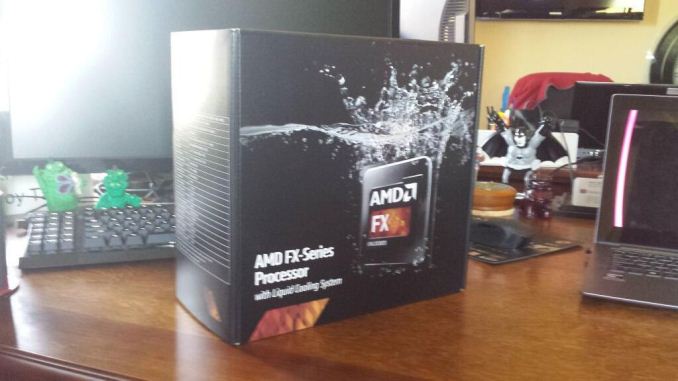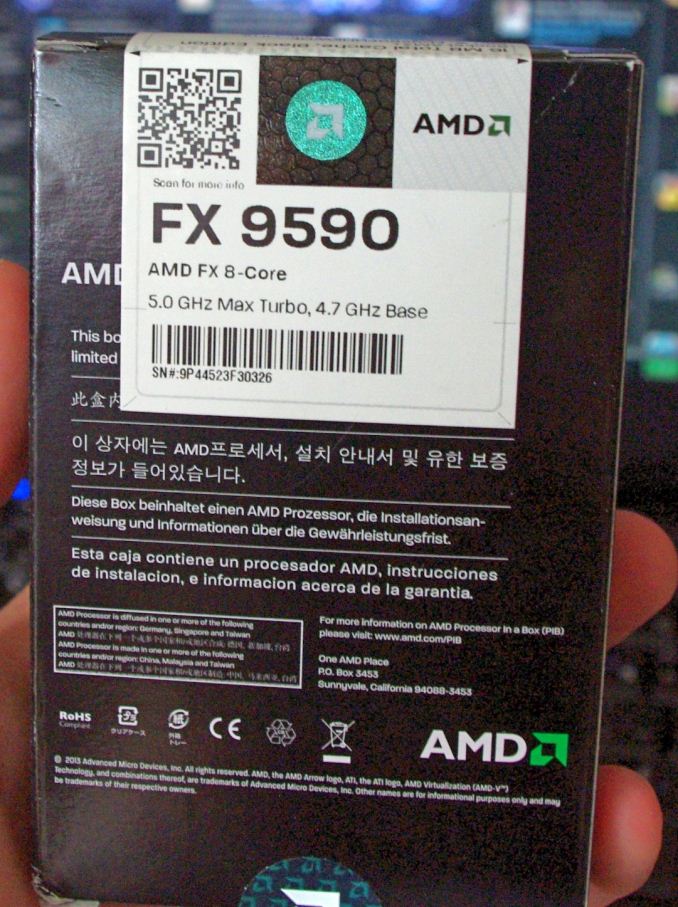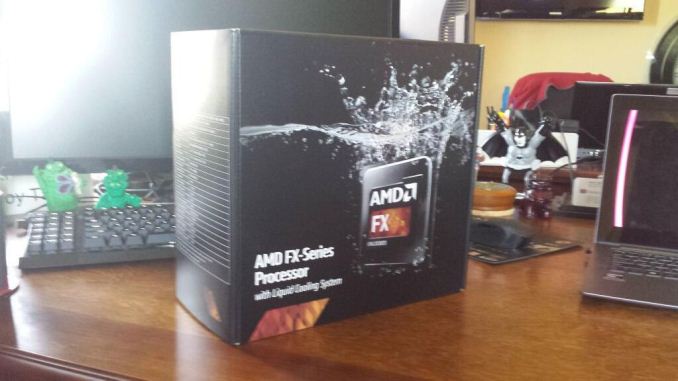AMD’s 5 GHz Turbo CPU in Retail: The FX-9590 and ASRock 990FX Extreme9 Review
by Ian Cutress on August 9, 2014 8:00 AM EST
While AMD’s FX-9590 CPU has been in systems for over a year, it suddenly comes to market as a retail package for end-users to buy with a bundled liquid cooling system. This 220W CPU that has a turbo speed of 5.0 GHz still sits at the top of AMD’s performance stack, despite subsequent improvements in the architecture since. We have decided to grab ASRock’s 990FX Extreme9 and an FX-9590 for a review to see if it still is the AMD performance CPU champion.
Spot the CPU
The story behind AMD’s fastest ever x86 CPUs is slightly odd. Two models, the FX-9590 and FX-9370, were both launched into OEM channels in June 2013. Being an OEM component, the only way to get one was in a pre-built system through a retailer, or through a bulk system integrator that had a model around one of these CPUs. Typically this is a process that is only exhibited with server class processors: from a range of CPUs being produced, only several will be available for end-users at retail because server CPUs usually go through a system builder. At the time, it seemed that AMD concerned that the high TDP of this CPU, at 220W listed, is too much for most cooling setups within a home user system and the best way to get it to consumers would be if a system builder chose the appropriate cooling for them.
As a result of this orientation of sales, AMD did not sample the media with review units. We review an AMD product typically though an AMD sourced sample. It was also noted that the OEM price for the CPU was near $900 for the FX-9590, which seemed like an excruciating amount for what was essentially a good overclocking version of the FX-8350. Several media websites were able to collaborate with system builders in order to get a chance to review the CPU, and AMD was confident in their promotion and handling of the new CPU.
Anecdotally, in my field of vision, the promotion of this CPU was relatively limited. The price was the main factor, resulting in comparative AMD/Intel systems being more power hungry on the AMD side, and substantially more expensive when put up against the latest mainstream i7 at the time. As a result, while some retailers were selling the OEM CPU at full price, some retailers decided to sell their OEM stock with a severe price cut directly to consumers, down from $900 to $390, in order to get rid of units (this is when I picked up our sample).
Due to the OEM nature of these sales to end-users, each CPU had either no warranty with AMD or a limited warranty. For the user interested in a 3-year system cycle without the fear of a bad egg, the OEM route is never a positive one.
AMD subsequently released, relatively silently, a proper package and retail version of the FX processors. It was apparent that this was in response to the OEM sales, with the retailers list ‘heatsink and fan not included’ alongside the specifications.
| AMD FX CPU Comparison | ||||||
|
FX- 4350 |
FX- 6350 |
FX- 8320 |
FX- 8350 |
FX- 9370 |
FX- 9590 |
|
| Release Date |
April 2013 |
October 2012 | October 2012 | October 2012 | June 2013 | June 2013 |
| Modules | 2 | 3 | 4 | |||
| L1 Cache (Code) | 128 KB | 192 KB | 256 KB | |||
| L1 Cache (Data) | 64 KB | 96 KB | 128 KB | |||
| L2 Cache | 4 MB | 6 MB | 8 MB | |||
| L3 Cache | 8 MB | |||||
| TDP | 125W | 220 W | ||||
| Base Frequency | 4200 | 3900 | 3500 | 4000 | 4400 | 4700 |
| Turbo Frequency | 4300 | 4200 | 4000 | 4200 | 4700 | 5000 |
| Core Name | Vishera | |||||
| Microarchitecture | Piledriver | |||||
| Socket | AM3+ | |||||
| Memory Support | DDR3-1866 | |||||
| Price (US) | $140 | $140 | $160 | $190 |
$230 $300 CLC |
$300 $370 CLC |
Since that release, AMD has not upgraded their enthusiast processor line with the latest architecture. The FX line has stayed where it is, perhaps for a number of reasons. One could speculate that releasing the next generation of FX-85xx might put them behind the FX-9590 in performance, or that the fabrication process was not suitable for a quad-module CPU with the new architecture improvements. The FX line for desktops, as far as we know, is staying at 32nm with no improvements.
Now Available
Fast forward twelve months to June 20th 2014 and Roy Taylor, AMD’s VP of Global Channel Sales tweets this innocuous picture:
Speculation was rife as to what this was. Here is a large box for an FX processor with the words ‘with Liquid Cooling System’ underneath. AMD supplied liquid cooling to the media when we reviewed the FX-8350 CPUs, the main CPU that sits underneath the FX-9590 and FX-9370, so there was an expectation that was something new.
On June 26th, the @AMDFX twitter account posted the following, confirming that this was the older FX-9590 but in a retail box with retail cooling:
To celebrate the start of ‘Round of 16’, we’re giving away eleven FX-9590 CPUs! #FXCUP pic.twitter.com/21JRaHdMq8 — AMD FX (@AMDFX) June 26, 2014
The AMD FX Processor page has been updated accordingly, showing the same render of the new box. Here we see that the liquid cooler is supplied by Cooler Master, and uses a wide range PWM fan as part of the package.
Of course, this leaves several questions unanswered: how much, when is it on sale, where is it on sale, and is it still any good? Well for the US at least, it is on sale today from Newegg at $370 with the water cooling kit, or $330 without. NCIX has it listed for CAD$500, although this is currently in ‘back stock’ mode.
The SKU to look for is the FD9590FHHKWOX, which in the UK does not seem to be on the shelves as of yet. Amusingly, when this is typed in to Google, the search engine asked me if I meant FD9590FHHKWOF, the non-CLC version.
This Review
Back when the FX-9590 was originally released alongside the FX-9370, we were unable to secure a sample from AMD and the limited availability made us feel the CPU had a fairly limited scope for testing. However, now the landscape has changed. There has been no new FX CPUs on the market from AMD, and this subsequent release of a retail version piques the interest as to how relevant AMD still sees their high-frequency part. Because I now have a FX-9590 all of my own to test from when the OEM stock was sold, I felt it was worth revisiting to see if it can be considered an investment.
Alongside testing this CPU, the 220W TDP requires a substantial motherboard to match. Due to the age of the platform, the AM3+ socket and the old 990FX chipset, finding a motherboard can be rather tricky. Many of the AM3+ motherboards that were launched were only suited for the FX-8350 processors, which had a 125W TDP. This is yet another reason that AMD wanted the FX-9590 in the hands of system builders who would chose high end motherboards that could cope.
Two of the newest motherboards to be released for 990FX were the ASRock 990FX Killer and the ASRock 990FX Extreme9. We reported the release of the Killer in December 2013, but the Killer is unsuitable here as the specification sheet lists processors up to 125W only. The Extreme9 is ASRock’s high-end AM3+ motherboard, and more suited to the task. Luckily I had requested a sample almost a year ago for some regression testing, so we will be reviewing this motherboard as part of this article.














146 Comments
View All Comments
Budburnicus - Wednesday, January 14, 2015 - link
+1 EXACTLY my point! People KEEP bringing up fab sizes, but it is a simple TRUTH that a 3 year old 32 nm SandyBridge is FAR faster in nearly every conceivable way - at STOCK speeds no less!Apply a 4.7 GHz overclock (as my SandyBridge system has ) - and the Per Clock (as well as gaming performance!) actually BEATS my Haswell i7-5930K (which with the same Cooler Master Hyper 212 EVO w/dual fans - is at a stable 4.4 Ghz) - in gaming!
Budburnicus - Wednesday, January 14, 2015 - link
*per CORE* - not clock (same IPC obviously)roadapathy - Monday, August 11, 2014 - link
In fact, I argued this point on my Steam Gamers group page and some said I was not fully understanding. I'll laugh a little about that because I talked with an employee of Intel at my work and he has a PhD in electrical engineering from Purdue. He said that I was correct and that the lithography makes a huge differences in power and performance of a CPU. Even if AMD CPUs/APUs are slower per IPC, it still does the job and it still costs much less to produce an entire PC system.Budburnicus - Wednesday, January 14, 2015 - link
Fab size isn't the problem here! A 3 year old i5-2500K or i7-2600K is built with a 32 nm fab and is only a 95 watt TDP part! On top of that, it is QUITE easy to overclock either to 4.7 GHz - and even then the power draw is at least 1/3 less and the CPU will be MUCH faster in EVERY way!Hell, at STOCK speeds, an i7-2600K is faster!
LarsBars - Saturday, August 9, 2014 - link
I wanted to build a Hyper-V lab for my work, so I ended up going with AMD FX. I don't care about overcook and the power consumption argument to me is not a big deal. I got my 8350 and 8320 on sale, and for the number of threads, the cache, and the hardware virtualization support, it was one of the cheapest ways to put together two 32 GB lab servers.Sttm - Saturday, August 9, 2014 - link
So this a fanboy only product? Not sure how anyone else can believe its a better purchase over an i7. Slower in most things, similar cost, multiple times the power usage.TiGr1982 - Saturday, August 9, 2014 - link
Well, for the unbiased customer there is indeed no sense in going with this FX rather than with i7.So, AFAIU, this is indeed a product for die-hard AMD fans. The only problem is that the number of these people is diminishing from year to year, I suppose.
darkich - Saturday, August 9, 2014 - link
What a terrible product.A 220W CPU now days?
Facepalm
gostan - Saturday, August 9, 2014 - link
I know AT team needs to eat. It's just painful to see them try so hard to be easy on AMD.darkich - Sunday, August 10, 2014 - link
+1